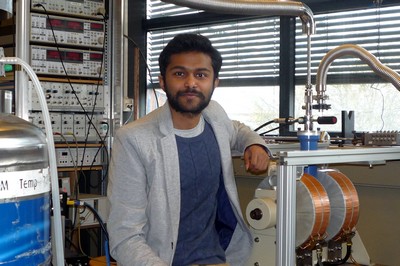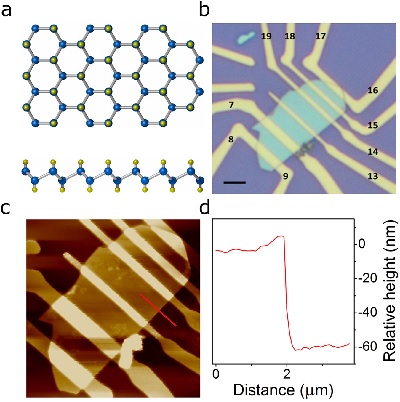The return of germanium transistors
In the first decade of semiconductor electronics, scientists used germanium. But as it was rather expensive, they switched to silicon. Now, University of Groningen PhD student Bettadahalli Nandishaiah Madhushankar has revived germanium in a new guise. He used very thin flakes of 2D germanane, the two-dimensional hydrogenated analogue of germanium, to build a transistor.
All sorts of new approaches are being tried out to make it possible to produce ever-smaller electronic devices. One approach is to use two-dimensional (2D) materials, such as the well-known graphene, a 2D version of graphite. The electronic properties of germanium are very good – that’s why early semiconductor work made use of this element – so scientists tried to make 2D germanene from germanium. ‘But that wasn’t very successful, because it turned out that this material was not very stable’, Madhushankar explains.

However, it turned out that germanene could be fortified by adding hydrogen atoms on both sides of the layer, using a chemical process. The result, called germanane, turned out to be much more stable. Madhushankar obtained germanane crystals from fellow researchers at the University of Ioannina in Greece and was able to produce thin flakes, using the now classic ‘Scotch tape method’.
He deposited very thin flakes onto a silicon substrate and connected them to gold electrodes which allowed him to send a current through the flakes. By applying a voltage bias across the silicon substrate, he was able to ‘gate’ (control) the current flow in germanane. Thus, he made a germanane transistor, which had never been done before with this material. Further, Madhushankar adds: ‘It's theoretically predicted that in germanane, charges move about five times faster than in germanium , which means you can make devices which operate at very high speeds.’
Improvement
The measurements Madhushankar made in this device indicate excellent electronic properties, although the electrodes appear to affect the germanane. ‘We still have to find out how this happens there’. Also, the electron mobility is much higher at low temperatures (77 Kelvin) than at room temperature. ‘So there is room for improvement.’ Another advantage of germanane over silicon is that shining light on the material produces or enhances a current. It could be used for making photovoltaics, but applications as a light sensor are more likely.

The first results obtained from the germanane device were published in the journal 2D Materials on 1 February. Madhushankar reports these findings together with postdoc Alexey Kaverzin, his PhD supervisor Bart van Wees and three other professors from the University of Groningen (Petra Rudolf, Graham Blake and Caspar van der Wal). Scientists from Professor Dimitrios Gournis’s group at the University of Ioannina, Greece, produced the germanane crystals.
Madhushankar is continuing his investigation of the new material. ‘I want to know why the contacts affect the electronic properties and do more optical studies. And I’d like to combine germanane with other 2D materials by stacking them. That might result in entirely new properties’.
Reference: B N Madhushankar, A Kaverzin, T Giousis, G Pots, D Gournis, P Rudolf, G R Blake, C H van der Wal and B J van Wees: Electronic properties of germanane field-effect transistors, 2D Materials, Volume 4, Number 2, 1 February.
| Last modified: | 16 March 2021 1.44 p.m. |
More news
-
16 April 2024
UG signs Barcelona Declaration on Open Research Information
In a significant stride toward advancing responsible research assessment and open science, the University of Groningen has officially signed the Barcelona Declaration on Open Research Information.
-
02 April 2024
Flying on wood dust
Every two weeks, UG Makers puts the spotlight on a researcher who has created something tangible, ranging from homemade measuring equipment for academic research to small or larger products that can change our daily lives. That is how UG...
-
18 March 2024
VentureLab North helps researchers to develop succesful startups
It has happened to many researchers. While working, you suddenly ask yourself: would this not be incredibly useful for people outside of my own research discipline? There are many ways to share the results of your research. For example, think of a...

